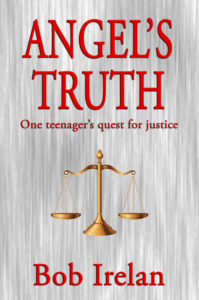



Outer Banks Publishing Group author Mary L. Tabor contributed her writing expertise on Day 3 of a 30-day writing challenge sponsored by Wattpad.
Watch her video on creating the right point of view
Learn more with Mary’s bestselling stories about women’s challenges in today’s hyperspeed society, The Woman Who Never Cooked. The book is now published in its second edition by Outer Banks Publishing Group and available in our bookstore, on Amazon and in bookstores everywhere. The book is
“The American adult woman is featured in this debut collection of stories about love, adultery, marriage, passion, death, and family. There is a subtle humor here, and an innate wisdom about everyday life as women find solace in cooking, work, and chores. Tabor reveals the thoughts of her working professional women who stream into Washington, D.C., from the outer suburbs, the men they date or marry, and the attractive if harried commuters they meet.
“Her collection of short stories The Woman Who Never Cooked, published when she was 60, won the Mid-List Press First Series Award.
“Mary Tabor writes with astonishing grace, endless passion, and subtle humor,” wrote reviewer Melanie Rae Thon.
https://www.outerbankspublishing.com/writing/novel-writing-is-like-taking-a-good-photograph/
WHEREVER THE TIDE OF LIFE TAKES YOU AND YOUR LOVED ONES
The Origin of New Year’s Day
From the History Channel
The first New Year’s Day was celebrated on January 1 in the year 45 B.C. for the first time in history as the Julian calendar took effect.
Soon after becoming Roman dictator, Julius Caesar decided that the traditional Roman calendar was in dire need of reform.
Introduced around the seventh century B.C., the Roman calendar attempted to follow the lunar cycle but frequently fell out of phase with the seasons and had to be corrected. In addition, the pontifices, the Roman body charged with overseeing the calendar, often abused its authority by adding days to extend political terms or interfere with elections.
In designing his new calendar, Caesar enlisted the aid of Sosigenes, an Alexandrian astronomer, who advised him to do away with the lunar cycle entirely and follow the solar year, as did the Egyptians.
The year was calculated to be 365 and 1/4 days, and Caesar added 67 days to 45 B.C., making 46 B.C. begin on January 1, rather than in March. He also decreed that every four years a day be added to February, thus theoretically keeping his calendar from falling out of step.
Shortly before his assassination in 44 B.C., he changed the name of the month Quintilis to Julius (July) after himself. Later, the month of Sextilis was renamed Augustus (August) after his successor.
Celebration of New Year’s Day in January fell out of practice during the Middle Ages, and even those who strictly adhered to the Julian calendar did not observe the New Year exactly on January 1. The reason for the latter was that Caesar and Sosigenes failed to calculate the correct value for the solar year as 365.242199 days, not 365.25 days. Thus, an 11-minute-a-year error added seven days by the year 1000, and 10 days by the mid-15th century.
The Roman church became aware of this problem, and in the 1570s Pope Gregory XIII commissioned Jesuit astronomer Christopher Clavius to come up with a new calendar. In 1582, the Gregorian calendar was implemented, omitting 10 days for that year and establishing the new rule that only one of every four centennial years should be a leap year. Since then, people around the world have gathered en masse on January 1 to celebrate the precise arrival of the New Year.

By Anthony S. Policastro, Publisher
While we can now communicate in the fastest, easiest and most convenient ways possible using a myriad of devices anywhere, anytime to anyone in any corner of the connected world, I believe we are losing our ability to communicate.
Because communication is now ubiquitous, convenient, easy and instant, we have taken our writing skills for granted. Take emails. I believe that most of us are so comfortable with communicating with this medium that we use it like we are conversing with a good friend. Facebook and Twitter reinforce this mindset because we know our posts and tweets are reaching friends and relatives.

Jeff Bezos
The result is a quantum disconnect fueled by snippets of information that are most times incomprehensible.
When you a sitting face to face and having a conversation, the context of what you are talking about is always top of mind. But when you converse in the same manner with email the recipient may not read email for hours or days. The context gets lost. Complicate that with several acronyms in the copy and you might as well call a cryptologist.
We tend to write emails as if the recipient is sitting across from us leaving out the content because we believe the recipient will know what we are writing about. We have become lazy writers.
And I’m not alone in my view.
Walter Chen in his blog, IDoneThis.com, wrote about Jeff Bezos, founder of Amazon who values writing over talking to such an extreme that in Amazon senior executive meetings, “before any conversation or discussion begins, everyone sits for 30 minutes in total silence, carefully reading six-page printed memos.”
Writing out full sentences enforces clear thinking, but more than that, it’s a compelling method to drive memo authors to write in a narrative structure that reinforces a distinctly Amazon way of thinking—its obsession with the customer. In every memo that could potentially address any issue in the company, the memo author must answer the question: “What’s in it for the customer, the company, and how does the answer to the question enable innovation on behalf of the customer?”
Like Bezos, Andy Grove of Intel finds value in the process of writing, but he doesn’t consider reading important. Grove considers the process to force
yourself “to be more precise than [you] might be verbally”, creating “an archive of data” that can “help to validate ad hoc inputs” and to reflect with precision on your thought and approach.
Writing, according to Grove, is a “safety-net” for your thought process that you should always be doing to “catch … anything you may have missed.”
So what is the solution? Write more, write casually, but include all the pertinent facts and pretend your reader knows practically nothing about what you are writing about.
By Anthony S. Policastro, Publisher When writing a novel it is a bit like taking that award-winning photograph. Don’t worry, you don’t have to take great photographs to be a great novelist.
In today’s world with dozens of media channels bombarding us every minute of the day, your book has to stand out from all the noise.
Here are elements that should be included in your novel and help to make your book stand out. You can pick and choose a few or include all, but you should have at least one.
Now here is how writing is like photography. Look at the photo below. Pretend it’s your realty – what you perceive through your senses. Now write a story about that photograph. You would describe the scenery, the asphalt path, the fallen leaves and twigs…overall what you wrote is pretty boring and a nondescript story unless those elements play a part in your plot.

Neuse River Greenway trail, Raleigh, NC
If you look closely or view the scene from a different angle or perspective there is a better story there. 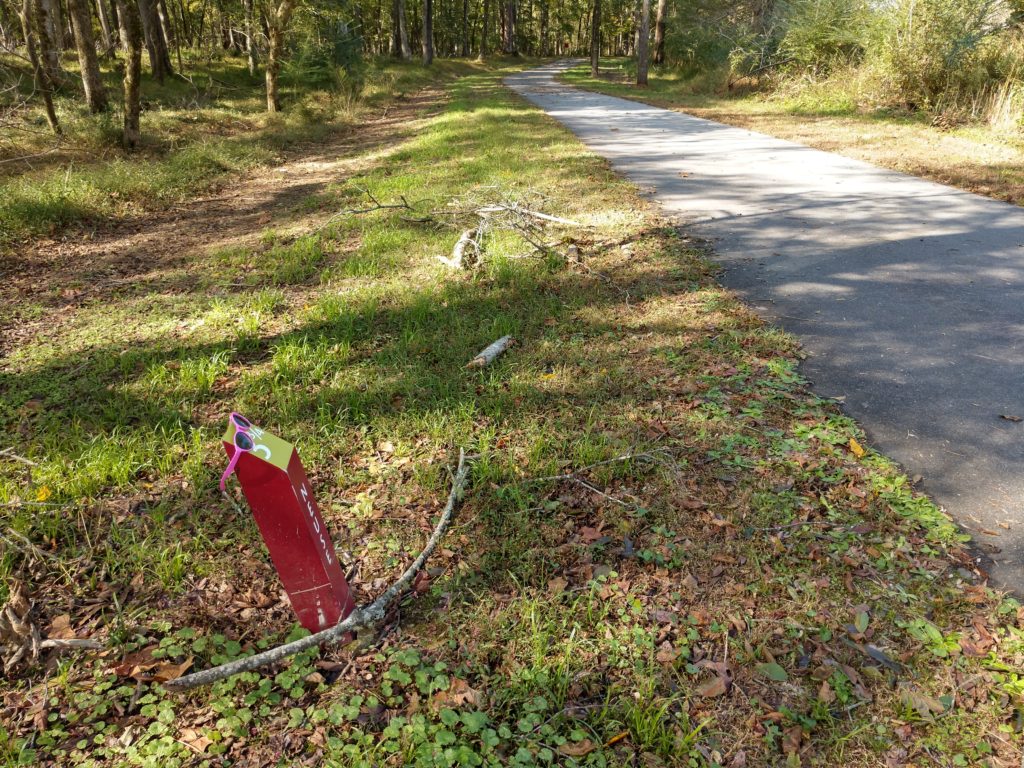 The story reveals itself upon a closer look – a nice person found the pink sunglasses on the trail and was considerate enough to place them on the milepost, hoping the person would pass this way again and find the sunglasses. Out of the reality emerges a story.
The story reveals itself upon a closer look – a nice person found the pink sunglasses on the trail and was considerate enough to place them on the milepost, hoping the person would pass this way again and find the sunglasses. Out of the reality emerges a story.  The photographer views and analyzes the light, shadows, colors, shapes and how they play against each other and then picks an angle or position for the shot. Writing is the same. A good book is like taking a snapshot of reality, analyzing that realty, digging deeper until the hidden story is found in plain sight and then putting it to words. Tell us what you think. We would love to hear your thoughts.
The photographer views and analyzes the light, shadows, colors, shapes and how they play against each other and then picks an angle or position for the shot. Writing is the same. A good book is like taking a snapshot of reality, analyzing that realty, digging deeper until the hidden story is found in plain sight and then putting it to words. Tell us what you think. We would love to hear your thoughts.

Did you know Halloween’s origins date back to the ancient Celtic festival of Samhain (pronounced sow-in). The Celts, who lived 2,000 years ago in the area that is now Ireland, the United Kingdom and northern France, celebrated their new year on November 1.
This day marked the end of summer and the harvest and the beginning of the dark, cold winter, a time of year that was often associated with human death. Celts believed that on the night before the new year, the boundary between the worlds of the living and the dead became blurred. On the night of October 31 they celebrated Samhain, when it was believed that the ghosts of the dead returned to earth.
 In addition to causing trouble and damaging crops, Celts thought that the presence of the otherworldly spirits made it easier for the Druids, or Celtic priests, to make predictions about the future. For a people entirely dependent on the volatile natural world, these prophecies were an important source of comfort and direction during the long, dark winter.
In addition to causing trouble and damaging crops, Celts thought that the presence of the otherworldly spirits made it easier for the Druids, or Celtic priests, to make predictions about the future. For a people entirely dependent on the volatile natural world, these prophecies were an important source of comfort and direction during the long, dark winter.
To commemorate the event, Druids built huge sacred bonfires, where the people gathered to burn crops and animals as sacrifices to the Celtic deities. During the celebration, the Celts wore costumes, typically consisting of animal heads and skins to ward off ghosts.
In the eighth century, Pope Gregory III designated November 1 as a time to honor all saints; soon, All Saints Day incorporated some of the traditions of Samhain. The evening before was known as All Hallows Eve, and later Halloween. Over time, Halloween evolved into a day of activities like trick-or-treating, carving jack-o-lanterns, festive gatherings, donning costumes and eating sweet treats.

Reviewed by Steven Felicelli
According to Ron Rhody’s wife, he is not eligible for authoring a memoir. He hasn’t won an Oscar or an MVP or a Nobel prize. And yet Rhody has a story he wants, needs, to tell. His story. And so that’s how he will tell it to us: as one of Our Own Little Fictions.
Reminiscent of Sarah Polley’s documentary Stories We Tell, Rhody meanders through his memory and down the real roads he’s traveled all over the U.S., from his beloved Frankfort, Kentucky, to California and back (via Florida and Alabama) and then back out to California. Along this circuitous route through his youth, manhood, and ancestry, we encounter all sorts of colorful characters, historical events, family triumphs, and tragedies, which in large part amount to the man whose story we’re being told.
The place closest to Rhody’s heart is clearly Frankfort, Kentucky. It is there his father, a newspaperman, fought for civil rights and to put down roots for his forward-thinking family. Though a wanderlust would uproot the Rhodys and send them all over the U.S., Kentucky kept calling them back to the heart of the heart of their country. In Our Own Little Fictions, Frankfort is origin and refuge, and it serves as the Ithaca of the author’s Odyssey.These chronicles of Rhody contain all the joy and pain of an American life that spans the Cold War to the present.
We meet his parents, grandparents, wife and children, friends and mentors. From animated anecdotes of a hard-nosed football coach doling out life lessons to the memorial for a dear friend and author of “sixteen erudite books,” we witness a life pass in time-lapse frames of laconic, Hemingwayesque prose.
Hemingway and his suicide haunt the narrative beginning to end. On a road trip from California to Kentucky, Rhody and his son make a scheduled detour to Hemingway’s home in Idaho (where he’d put the shotgun in his mouth).
”It seemed wrong that Hemingway had killed himself. Nature should have gotten him. Or chance.”
Later in the narrative and earlier in time, news of Hemingway’s suicide reaches Rhody, and he reflects on the premature tragedy, as well as his own (missed?) calling. These two time periods intermingle, and Rhody leaves Idaho with “an answer to a question I hadn’t known I’d asked.” Authorship was an alternative path he’d bypassed only to embark upon late in life.
Later in the narrative and earlier in time, news of Hemingway’s suicide reaches Rhody, and he reflects on the premature tragedy, as well as his own (missed?) calling. These two time periods intermingle, and Rhody leaves Idaho with “an answer to a question I hadn’t known I’d asked.” Authorship was an alternative path he’d bypassed only to embark upon late in life.
Late in life, indeed. The long road approaches its end and the loss of loved ones is an inevitability. Each story has the same conclusion, alas, and many of the characters we encounter in this Appalachian saga pass on in heartrending deathbed scenes and austere funerals. The depiction of these tragedies is sentimental, even cliched, but anything less/more would not be true to life. It is the commonality of these cliches that arise in endless variations, like updates of Shakespeare.
No, Ron Rhody is no Prince Hamlet, nor was he meant to be, but his story of “becoming,” with its conduplicatio, terse punch-lines, and homespun wisdom, is one that will always be in need of telling and retelling.
The feature photo above from left, Ron Rhody’s sister, Ann, his mother and sister, Mary Lou.
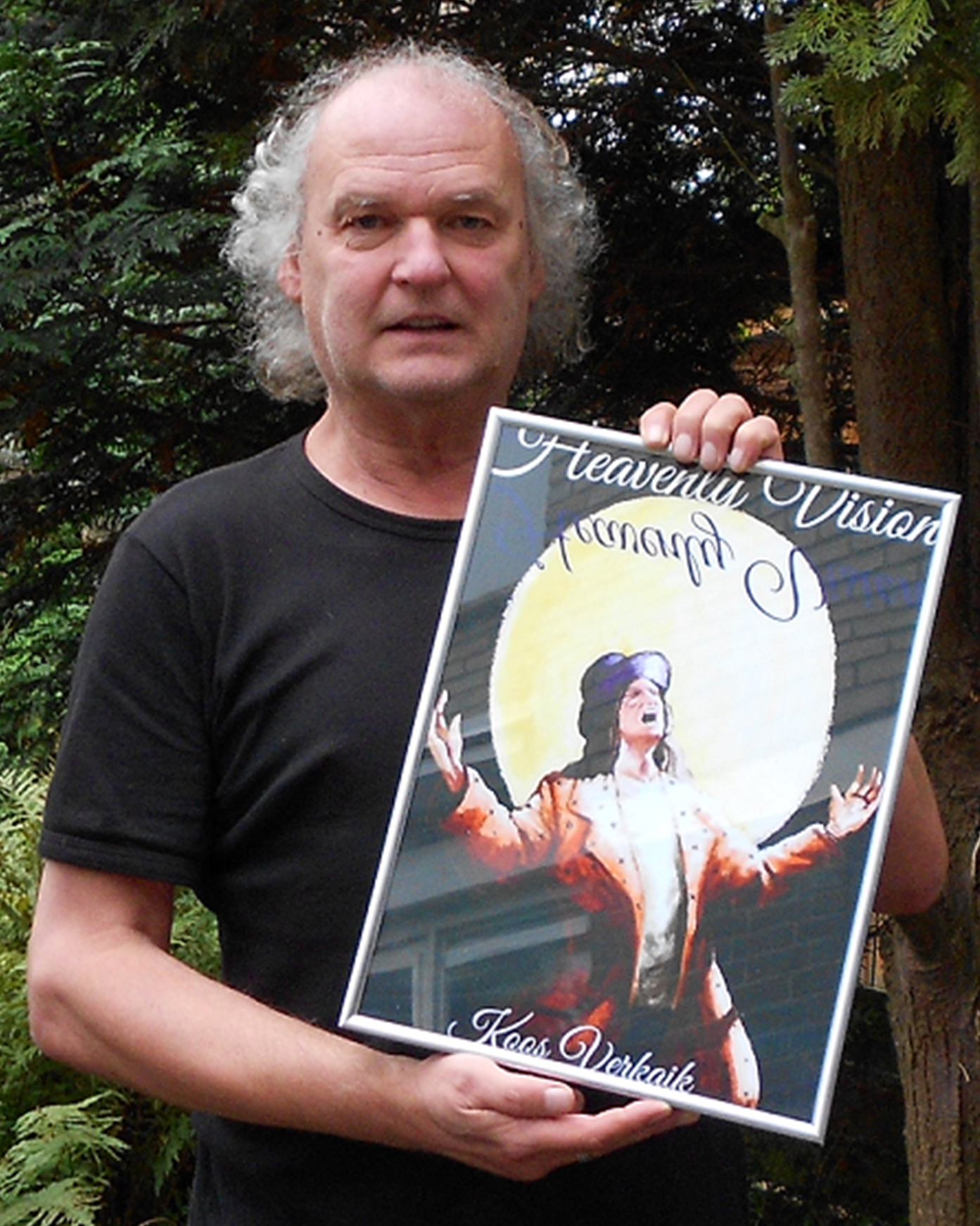
Koos Verkaik’s newest novel Heavenly Vision is about a book collector who finds a manuscript in a 1745 Atlas of the Cape of Good Horn that changes his life forever. Read the interview by Deborah Kalb on how Koos was inspired to write the murder mystery, Heavenly Vision.
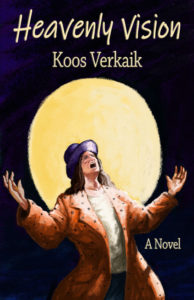
Q: How did you come up with the idea for Heavenly Vision?
A: For most of my books all I need is one simple fact. One line, one thought, will do to get me start writing. Where Heavenly Vision is concerned, I was intrigued by the fact that you can buy yourself an old book at a flea market and find a priceless drawing or etching between the yellowed pages! That stimulates my fantasy and I get cracking right away – not knowing at all where and when it will end.
I always start to write the first two or three pages with a simple pen on sheets of paper. Only after I know it is all right, I start working on a computer.
Sitting down in silence and write the lines with a pen is something I will always enjoy.
Q: The book takes place in a variety of locations and times. Did you write the novel in the order in which it appears, or did you move chapters around as you wrote?
A: I wrote it in the order in which it appears! When I start writing, there is a complete chaos in my head, but the manuscript must be one hundred percent all right. I make notes on sheets of papers, on beermats, on three different laptops, sometimes on the back of my hand – but finally it all comes together in the manuscript.
After having typed “The End,” the chaos has disappeared. The work is done. Then I take a deep breath… and start working on the next project.
Q: Did you know how the book would end before you started writing it?
A: I never know how my books will end. I know there are authors who make a storyboard, who only start writing after they have figured it all out.
For me every new book is an adventure – for myself and for my readers. The story grows and to be honest; I do know where to go with my stories, it is all somewhere in my head and it has to come out. I never had writer’s block; I have written since I was 7 years old and as a boy I worked at night and saw the sun come up.
Q: How did you research the novel, and did you learn anything surprising?
A: Research is always important. And… the internet is there for the common facts, books are there for the real information. In my work room I am surrounded by a couple of thousand books; I absorb the facts and write fantasy.
Right now I am reading Sapiens and Homo Deus from Yuval Noah Harari. Such a great writer about the history and the future of mankind.
For Heavenly Vision I didn’t have to do much research. Most of the things I wrote about (such as the Dutch East India Company) were already known to me. I am a collector of nonfiction books about science, but also about alchemy, the supernatural, mysterious historical facts, etc. Life is full of odd surprises and I love to write about it.
Q: What are you working on now?
A: I always write different books at the same time. There are two series of children’s books, Saladin the Wonder Horse and Alex and the Wolpertinger. Finished the last book of Saladin and work on book 14 of The Wolpertinger; intending to write over 30 different titles.
A new publishing company contracted me for all my novels: Righter’s Mill Press, Princeton. They also have a film company, Three Corners Entertainment. Signed contracts for all titles.
Right now I also started a new novel. And I never tell about a new story until it is finished… When I explain all about it, I feel less urge to complete it.
Q: Anything else we should know?
A: Yes. Heavenly Vision was published earlier by a Canadian company. Unfortunately the publisher passed away. We had become such good friends, She was such a great person.
Now Outer Banks Publishing Group has taken over; they will also publish my novel The Nibelung Gold soon and they already published the two series of children’s books I mentioned above.
I received wonderful reviews for the first edition of Heavenly Vision, which made me very proud (believe me, it is a great adventure and also a great honor to be published in Canada and the USA when you are a writer from faraway Holland).
About Koos Verkaik
Koos Verkaik, who lives outside of Rotterdam, Holland, is the author of more than 60 books from children’s series to mysteries to sci-fi. When his novels, All-Father and Wolf Tears were published, he earned the moniker as the Dutch Stephen King.
About the cover of Heavenly Vision
The cover was commissioned and created by Doriano Strologo, an illustrator in Numana, Italy, depicting the main character in the book, the mysterious Raso, the man who had the heavenly vision.
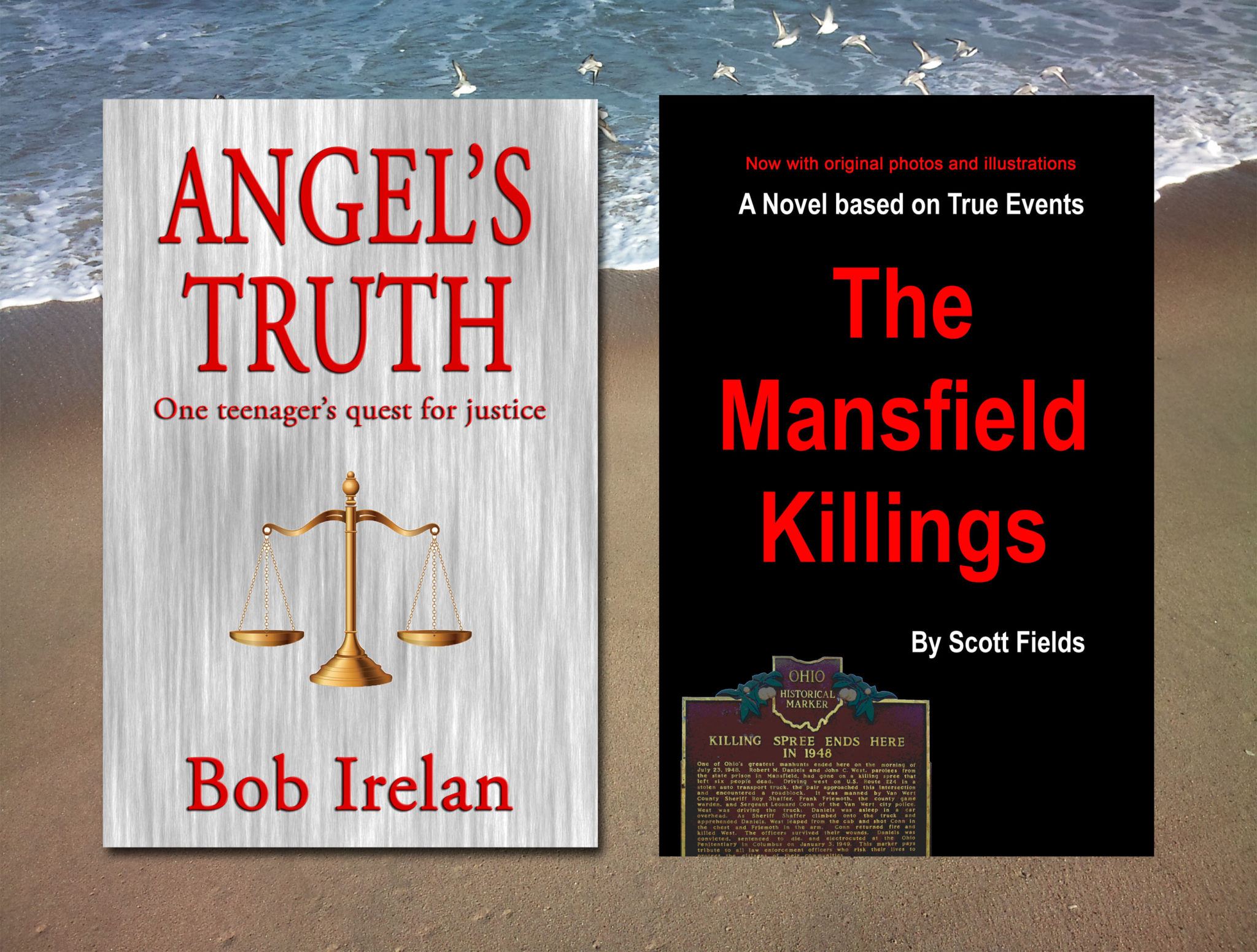
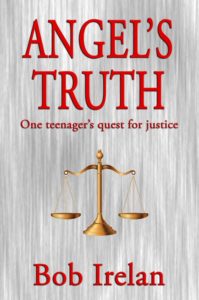
List Price: $15.99
5.5″ x 8.5″ (13.97 x 21.59 cm)
Black & White on White paper
268 pages
Outer Banks Publishing Group
ISBN-13: 978-0990679080
ISBN-10: 099067908X
BISAC: Fiction / Crime
Angel Gonzales is charged with heinous crimes that law enforcement, the media, and most folks in Richmond, Texas, and surrounding communities are certain he committed.
The crimes and trial dwarf anything that has happened in that part of the Lone Star state in anyone’s memory.
When, against all odds, the jury renders “not guilty” verdicts, shock escalates to anger.
In the minds of many, justice has failed, and a brutal criminal is being set free. For Angel and his court-appointed public defender, Marty Booker, being judged “not guilty” isn’t enough.
Together and with help from an unanticipated source, they attempt to prove Angel’s innocence.
In the process, they butt up against prejudice, deceit, and a sheriff and district attorney who put politics, ambition, expedience, and arrogance above responsibility to do their jobs.
It’s a story of horror, hatred, belief, and persistence – a story of a Mexican-American teenager who nearly loses his life on the way to becoming a man.
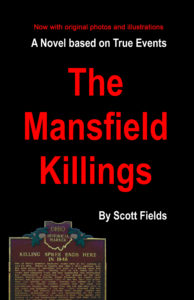 BASED ON TRUE EVENTS
BASED ON TRUE EVENTS
SOON TO BE A MAJOR MOTION PICTURE in 2019
Price: $14.99
5.5″ x 8.5″ (13.97 x 21.59 cm)
Black & White on Cream paper
280 pages
ISBN 10 – 0982993137
ISBN 13 – 978-0-9829931-3-2
Binding Type: US Trade Paper
Language: English
On the night of July 21, 1948, Robert Daniels and John West entered John and Nolena Niebel’s house with loaded guns. They forced the family including the Niebel’s 21-year-old daughter, Phyllis, into their car and drove them to a cornfield just off Fleming Falls Road in Mansfield. The two men instructed the Niebels to remove all of their clothing, and then Robert Daniels shot each of them in the head.
What followed was the worst two-week killing spree in the history of Ohio.
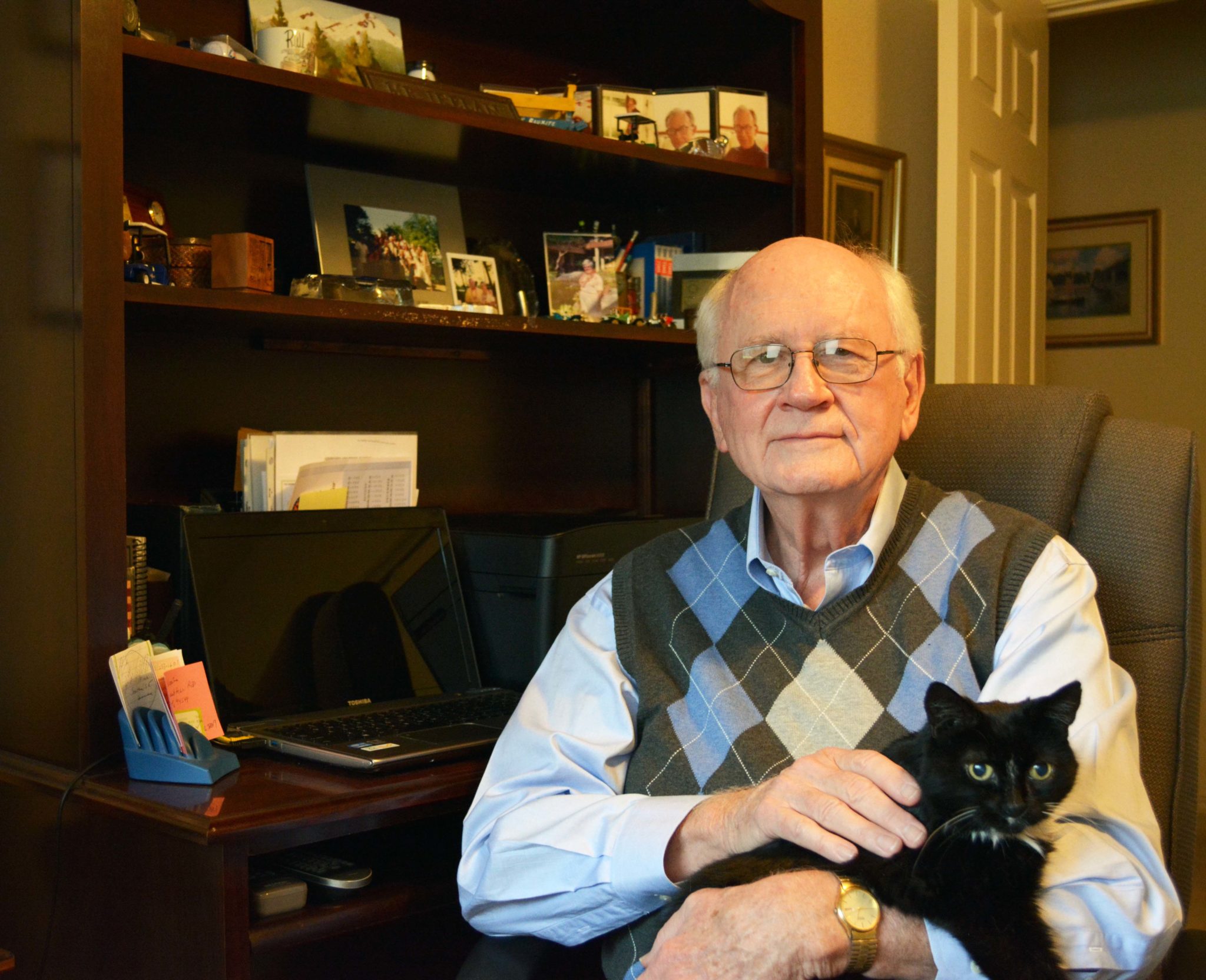
In this interview with Outer Banks Publishing Group author Bob Irelan, he reveals what inspired him to write the novel, Angel’s Truth and hopes to help people realize that justice is not always applied fairly, especially when it to comes to racial minorities.
 Bob, this is your first novel. What inspired you to write it?
Bob, this is your first novel. What inspired you to write it?
Writing was a large part of what I did during my career — first in journalism and then in public relations/communications. But, until this book, I had always dealt with facts. Reading fiction was my release and I have always appreciated a story well told. In retirement, I found the time to attempt writing this novel. It’s liberating to shape a story, make it believable, but not be bound by actual happenings. With respect to the plot, I’ve most always rooted for the underdog. For me, the character Angel Gonzales fills that role in his fight for true and lasting justice.
Were the characters inspired by real life people?
Public Defender Marty Booker was shaped at least in part by a public defender I was exposed to years ago as a member of a jury. I was impressed by how hard he worked on behalf of his client, a minority. Angel and the others were creations of my imagination.
You started your career as a journalist and then moved into corporate public relations and communications. How did you research the information for the story? Did you have any experience in the justice system?
I have to admit I didn’t do a lot of research. I lived in Sugar Land, TX, near Richmond, where the story takes place. Those locations and nearby Rosenberg are real but my description of them — most of the buildings, the park, etc. — is made up. I decided to create a setting that would work with the story I wanted to tell. My knowledge of the justice system is limited, but it’s drawn from jury service, a lifetime of reading and viewing courtroom dramas, and having a father who was a lawyer and a U.S. Attorney.
How long did it take you to research and complete Angel’s Truth?
The better part of a year, although I sometimes took breaks of a week or two. I admire writers who discipline themselves to a daily schedule. I’m sure that’s a more efficient approach than the one I followed.
I wanted to make the point that the truth often is not obvious; that finding it takes persistence, commitment and, if you’re lucky, some help from unanticipated sources. I also wanted to remind the reader about how, too often, justice is unevenly applied — especially as it relates to racial minorities. We’re not yet where we need to be as a fully inclusive society. Despite this, I wanted to write a story where hard-fought truth prevails.
Will there be a sequel? Will you write another book?
I’m not sure, but probably. I found the challenge of creating a plot and developing the characters to give it life very stimulating. Also, in writing this first novel, I overcame some personal doubts and uncertainties. For instance, I had not really written dialog before so that took some learning. The reader will judge whether I succeeded.
Do you prefer fiction or nonfiction and why?
I don’t have a preference. l love biographies and works of history. But I also love fiction, especially mysteries and those that include some courtroom drama. I admire greatly those who write well, those who can draw a picture for the reader. I love a book that grabs my attention and leaves me wondering how the heck the author came up with this or that idea.
Who are your favorite authors and did any inspire you to write Angel’s Truth?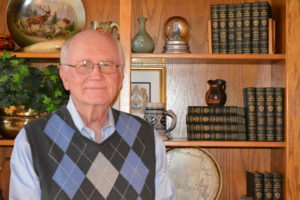
I like John Grisham, Mark Sullivan, David Baldocci, Dan Brown, to name a few. I also like historical novels by authors like Ken Follett, Erik Larson, and Anthony Doerr. In my mind, they are all amazing story tellers. And, yes, I drew inspiration from all of them as well as others.
As a first-time novelist, do you have any advice for potential authors starting their first book?
Yes. Just start writing. Don’t wait until you have everything figured out before you start. Don’t be deterred by not knowing at the outset how your story is going to end. Keep writing and see where your imagination takes you. Learn from the words and phrasing of writers you admire. Bounce ideas and text off people whose judgment you respect — those who will tell you if something is good or not. Take breaks when you need to but commit yourself to a finished product. You’ll be glad you did.
Is there anything you would like to add?
Take your time. Don’t rush the process. This was advice I got from an experienced, successful pro, and it proved to be very helpful. Don’t be shy about asking for help. There are a lot of smart people out there willing to hold your hand on this exciting journey.
___________________________________
Angel Gonzales is charged with heinous crimes that law enforcement, the media, and most folks in Richmond, Texas, and surrounding communities are certain he committed.
The crimes and trial dwarf anything that has happened in that part of the Lone Star state in anyone’s memory.
When, against all odds, the jury renders “not guilty” verdicts, shock escalates to anger.
In the minds of many, justice has failed, and a brutal criminal is being set free. For Angel and his court-appointed public defender, Marty Booker, being judged “not guilty” isn’t enough.
Together and with help from an unanticipated source, they attempt to prove Angel’s innocence.
In the process, they butt up against prejudice, deceit, and a sheriff and district attorney who put politics, ambition, expedience, and arrogance above responsibility to do their jobs.
It’s a story of horror, hatred, belief, and persistence – a story of a Mexican-American teenager who nearly loses his life on the way to becoming a man.